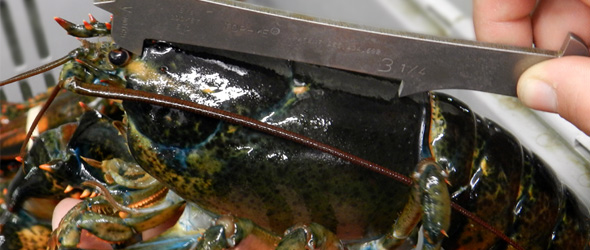Protecting Maine Lobsters
sustainability is key!Lobsters are measured for legal size
In the US, the minimum legal size lobster must measure at least 3¼” from the eye socket to the back of the carapace where the tail joins the body. The measure was increased twice in the last ten years, and allows more females to extrude eggs and reproduce before reaching legal size.
In Maine, a maximum size law also exists
Any lobster with a greater than 5” carapace must be returned to the sea. This law exists to protect the “breeders”. Larger lobsters are capable of reproducing greater and healthier numbers of offspring and Maine lobster harvesters feel very strongly about protecting this brood stock.
Here is a lobster being checked for legal size. Note the measure checking from the eye socket to the back of the carapace. This lobster is clearly above the legal minimum size.
"Berried” females (those carrying eggs) must be returned to the sea
After the tail has been marked with a v-notch in the right flipper next to the middle flipper. This ensures that the viably reproductive female will continue to produce young lobsters until she outgrows the notch in her tail, which may take up to two molting (shedding) cycles or approximately two years. The practice of notching and returning females provides a 10-30% return to the brood stock, a significant contribution to protect the resource.
These two Maine laws (maximum size and notching females) in effect since the 1930s have been recently adopted in federal waters. Lobster harvesters may voluntarily re-notch females to provide the resource with an ongoing brood stock.
Maine lobster harvesters have created the “Maine Lobster Seed Fund” from a portion of the lobster license fee they pay. Proceeds from this fund are used to purchase, and then return to the wild, female lobsters that have produced eggs while in captivity, but after they have been landed by the lobster harvester.
Lobsters are stored in recirculating tanks on board the vessel
This allows the harvester to land a healthy and robust product for the market.
If a lobster is of legal size, both of the lobster’s claws are banded to protect the lobsters from injuring one another in captivity.
- Harvesting text courtesy of Maine Lobster Promotion Council -


